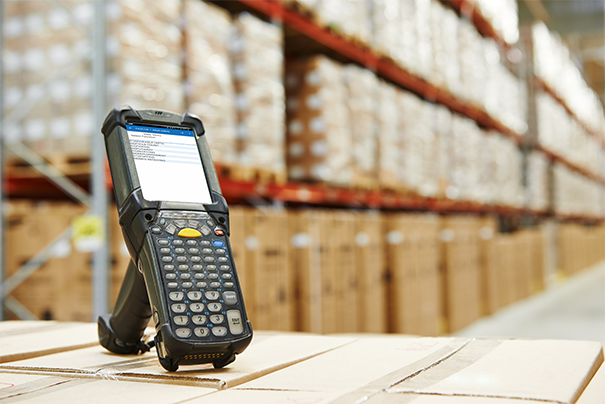In this blog we will talk about the available types of devices, where they work the best and the critical questions to ask before buying. It is important to note, the first step in creating your mobile device strategy will be to contact your WMS provider, they can give you insight into what operating system works best, and if there is a preferred device OS.
Mobile Handhelds
Mobile handheld devices are the standard in many warehouses. These all-in-one devices have a built-in scanner that is idea for medium to long range scanning and can be used in receiving, picking, putaway and shipping. They are rugged and have superior drop ratings (depending on make and model) and they are made for the rigors of warehouse work.
Wearable Devices
The one problem with a handheld scanner is just that, you have to hold it in one hand to use the device. With wearable tech you’ll eliminate repeating action such as the holstering and upholstering of the handheld device and increase productivity as your workers can now work faster with both hands. Most wearable device include a keyboard and small monitor worn on the arm with a small ring scanner worn on the hand. Cost can be factor as wearables can be more expensive depending on the make and model.
Tablets
Tablets can be an excellent solution for your vehicles in the warehouse. Its large screen and the ability to be directly mounted to the vehicle allows the driver to read the info on where to deliver or store pallets. Often paired with a long-range handheld scanner, the tablet can take the guess work out of warehouse logistics.
Tablets can also be used on the floor warehouse, however due to their size and ruggedness, tablets are normally a tool of managers that need to access data while on the warehouse floor.
Questions to ask
Here are a few key questions to ask your team and yourself to help narrow down the right device for you.
- Who will be using the device? While evaluating devices, you will need to evaluate your staff and their needs. How many devices will be in use during a normal day of operation? How many devices will be needed as back-up? How will the staff be using them can help you decide what type of device is needed or if you will need a blended approach.
- What kind of barcodes will you be scanning? Just like warehouse devices, barcodes come in many different sizes and types. The most common is the basic line barcode also known as a 1D code. This code is scanned with the red laser line scanner then transmits a specific number that is then matched in a database. Be sure to know what types of 1D codes you will be scanning as there are many different types including: UPC, EAN, Code 30, Code 128, Interleaved and GS1 to name a few. 2D codes have started to gain traction as these codes can be smaller, but hold more information in them, such as born on date, lot and serial numbers. However, to read these codes your device will need to have scanner that includes a camera. These codes include: Datamatrix code, QR Codes, PDF 417 and Aztec
- What is the scanning distance? Creating a warehouse device strategy is all about finding the sweet point for your operations. Finding the right device that can scan at the optimal distances that your business demands. Spend or work a shift in the warehouse to get a good idea of what your staff will need to be productive.
- What temperature will the devices be used in? This might be one of the most overlooked options when investigating a device. It is important to take the environment and swings in temperature into consideration. Devices can have adverse reactions to humidity, extreme cold or rapid changes in temperature. Not all devices are made to stand up to unique conditions.
Want some help? Talk with FASCOR’s device experts to get more information. Click here to schedule some time with one of FASCOR mobile device experts.

